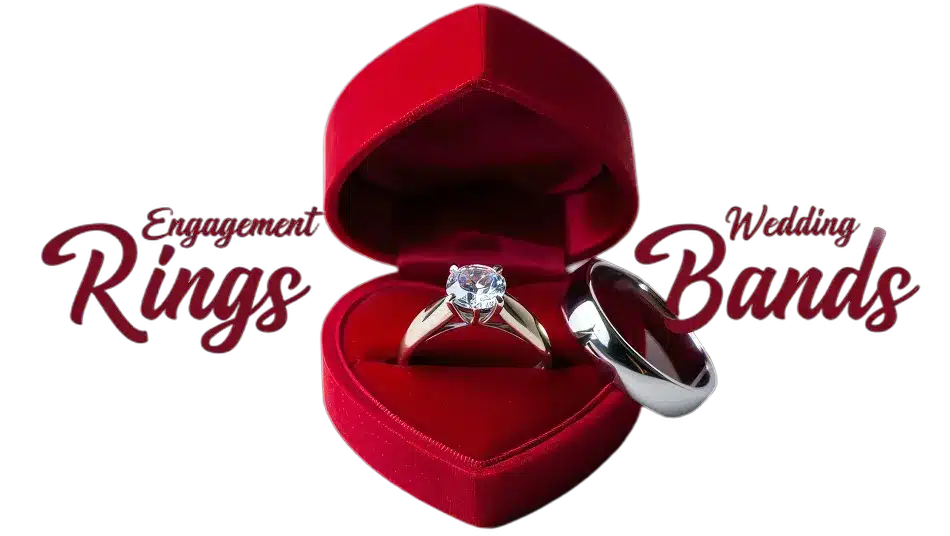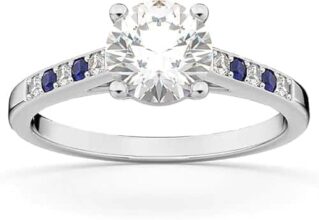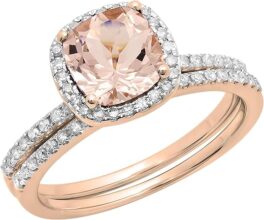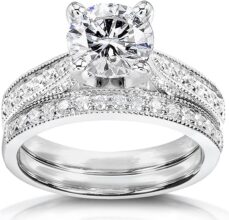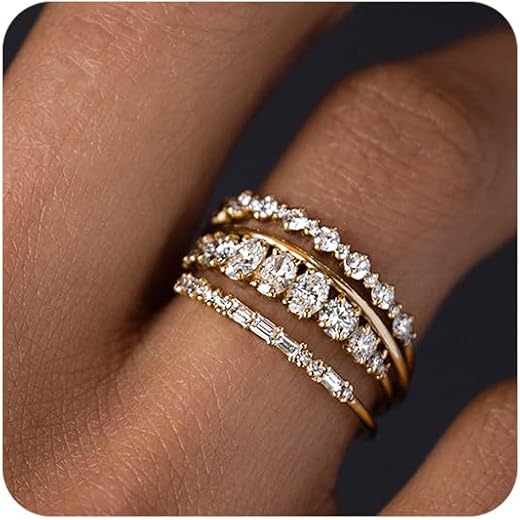
Understanding Engagement Ring Costs
Did you know that the average price of an engagement ring has steadily climbed to over $6,000 in recent years? For many, this number can feel overwhelming, especially if it doesn’t align with your financial situation. But fear not: finding the perfect ring doesn’t mean you have to drain your savings or go into debt.
In this article, we’ll explore the factors that influence engagement ring prices and help you determine a budget that feels right for you. You’ll learn about traditional pricing rules, the essential qualities of diamonds (or other gems), and where to shop for the best deals. Whether you’re a first-time buyer or looking to upgrade, we’re here to guide you in discovering the perfect ring without breaking the bank. Let’s get started on finding that dream ring at a price that works for your lifestyle!




Setting Your Budget: What’s Realistic for You?
Before diving into the world of engagement rings, it’s crucial to establish a budget that aligns with your financial situation. Setting a realistic budget can often feel daunting, but it’s an essential step to ensure your purchase doesn’t lead to financial strain.
Assessing Your Finances
Start by taking a close look at your current financial picture. Consider your monthly income, existing expenses, and any upcoming financial obligations. Are you saving for a house, planning a wedding, or maybe looking to travel? It’s important to factor these goals into your budget. For example, if you’re paying off student loans or credit card debt, it might be wise to allocate a smaller percentage of your finances towards the ring.
Consider Your Savings
Next, evaluate your savings. Determine how much you have saved up specifically for this purchase or how much you can comfortably set aside in the next few months. A realistic budget might come from a combination of your savings and a willingness to spend within your comfort zone. Remember, while it’s easy to get caught up in the excitement, there’s no rush. Take your time.
What Factors to Take into Account
When setting your spending limit, consider the following factors:
With a clear understanding of your financial situation, you’ll be in a stronger position to select a ring that reflects both your partner’s desires and your economic realities.
As you continue refining your budget, you’ll soon want to explore if the traditional two-month salary rule still holds relevance in today’s market—let’s dive into that next!
The Traditional Two-Month Salary Rule: Still Relevant?
The “two-month salary” guideline has been a long-standing rule of thumb when it comes to budgeting for an engagement ring. But as you start to plan your purchase, you might wonder: is this rule still relevant in 2025?
Origins of the Rule
This guideline gained popularity back in the 1980s, largely thanks to a clever marketing campaign by diamond companies aiming to boost sales. The idea was simple: if you truly value your partner, you should invest a significant portion of your income into the engagement ring. But as societal norms have evolved, so too has the perception of what an engagement ring should cost.
Evaluating Its Relevance Today
Fast forward to today, the economic landscape has changed dramatically. While some still cling to the two-month rule, many couples find it impractical and outdated. Young couples are often juggling student loans, rising living costs, or saving for a home. For many, spending a couple of months’ salary on a ring might not align with their financial goals.
Tailoring It to Your Situation
Consider your unique circumstances instead. If your salary is $60,000, the two-month rule would suggest a ring price of $10,000. However, if you’re working towards significant financial goals, like starting a family or buying a house, you might decide to invest less. The goal should be to choose a ring that reflects your love and commitment without compromising your financial stability.
To make your budget more personal, think about:
As you navigate through crafting your budget based on these considerations, you’ll be better positioned to understand the intrinsic value of the ring you choose—beyond just its price tag. Next, let’s dive into understanding the 4 Cs: Cut, Color, Clarity, and Carat Weight, essential factors that will further guide your purchasing decision.
Understanding the 4 Cs: Cut, Color, Clarity, and Carat Weight
When it comes to diamonds, the quality is vital in determining its price and beauty. Understanding the 4 Cs—Cut, Color, Clarity, and Carat Weight—will empower you to make an informed decision that resonates with both your aesthetic preferences and budget.
The Importance of the 4 Cs
Cut
The cut of a diamond affects how it reflects light, influencing its brilliance and sparkle. The most common cuts are round, princess, and oval, but there are many other shapes to consider. A well-cut diamond will exhibit a stunning interplay of light and shadow; for example, a round brilliant cut maximizes sparkle. However, it’s also important to balance cut quality with your budget. A slightly lower grade in cut could save money while still providing a gorgeous ring.
Color
Diamonds come in various colors, graded from D (colorless) to Z (light yellow or brown). A higher clarity grade means fewer inclusions, making the diamond appear more brilliant. If you’re working with a tighter budget, consider diamonds in the G-H range, which still look stunning to the naked eye but offer a price benefit compared to D or E graded stones.
Clarity
Clarity refers to the presence of imperfections or inclusions within a diamond. Graded from Flawless (F) to Included (I), clarity impacts price substantially. Many inclusions are microscopic and not visible without magnification, so aim for a clarity grade of VS1 or VS2. These diamonds offer excellent value, providing beauty without the cost of flawless gems.
Carat Weight
Carat weight measures the size of the diamond, but it’s essential to consider that two diamonds of the same carat can look different based on cut and shape. For budget-conscious shoppers, opting for just below a full carat—like 0.90 carats instead of 1.00—can offer significant savings while still appearing sizeable.
These 4 Cs interplay to create the final price and appearance of a diamond. Depending on your priorities, you might choose to focus on one or two Cs that resonate most with your vision of the perfect ring. For instance, if you value sparkle, prioritize cut; if size is most important, focus on carat weight.
As we look ahead, you’ll discover exciting alternatives to traditional diamonds—stones that can offer unique beauty and often come at a fraction of the cost. Let’s explore those options!
Alternative Gemstones: A Trend Worth Considering
If diamonds aren’t your only option, exploring alternative gemstones can significantly impact your budget. With more couples moving away from traditional choices, various vibrant alternatives are gaining popularity. Let’s take a closer look at some stunning alternatives—sapphires, emeralds, and lab-created diamonds—that not only enchant but can also be more budget-friendly.
Sapphires
Sapphires are a favorite among brides-to-be, renowned for their rich blue hues but available in a rainbow of colors. Not only do they showcase remarkable durability (second only to diamonds), but they are also generally more affordable. For example, a sapphire engagement ring can start at a fraction of the cost of a comparable diamond ring. This means you can opt for a larger carat weight without breaking the bank, creating a statement piece that stands out.
Emeralds
If you’re looking for something striking, consider emeralds. Their lush green tones symbolize rebirth and love, and they can bring a unique flair to your engagement ring. However, it’s worth noting that emeralds can be more fragile than sapphires or diamonds, making them better suited for low-wear situations. Nonetheless, their rarity adds charm, and many couples find them particularly romantic.
Lab-Created Diamonds
Lab-created diamonds are an excellent way to benefit from the characteristics of natural diamonds at a more accessible price. These diamonds are chemically identical to mined ones but are often 20-40% cheaper. The added bonus? They come with ethical considerations since their production doesn’t involve mining. With many options available, you can select a lab-grown diamond that meets your specifications without sacrificing quality.
As you explore these vibrant alternatives, keep in mind their unique qualities and what resonates with you and your partner. Choosing an alternative gemstone can offer something truly personalized, emphasizing your style and story.
Next, we’ll discuss the best places to shop—whether online or in-store—to ensure your chosen gemstone or ring fits your vision perfectly.
Where to Shop: Online vs. In-Store
When it comes to purchasing an engagement ring, where you shop can have a significant impact on your decision-making process. Each shopping avenue, online and in-store, comes with its unique advantages and disadvantages affecting aspects like pricing, selection, and customer service.
Online Shopping: Convenience and Variety
Shopping for engagement rings online has become increasingly popular, and for good reason. Here are some of the main benefits:
However, buying online does have its pitfalls:
In-Store Shopping: Personal Touch
Shopping in a physical store offers a different experience:
Yet, in-store shopping also has its drawbacks:
As you weigh these considerations, think about what matters most to you in the shopping experience. Whether you lean towards the convenience of online shopping or the personal touch of a storefront, your decision will ultimately influence how comfortable you feel about your purchase.
Now, it’s time to explore financing options that can make purchasing that perfect ring even more manageable!
Financing Your Purchase: Smart Strategies
If your dream ring seems just out of reach, don’t worry—there are financing options available that can bridge the gap between desire and reality. Let’s explore different financing methods, including credit cards, personal loans, and store financing plans, and how you can manage payments responsibly.
Credit Cards
Using a credit card is one of the most common ways to finance a purchase like an engagement ring. Here are some things to consider:
Personal Loans
A personal loan can be a great alternative if you need a larger sum:
Store Financing Plans
Many jewelers offer financing options directly, making it convenient to purchase your ring without immediate full payment:
Tips for Managing Payments
Regardless of the financing avenue you choose, responsible payment management is crucial:
Navigating the various financing options for an engagement ring doesn’t have to be daunting—you just need to be informed. Now that you have a clearer picture of your financing strategies, let’s wrap everything up and find that perfect price point for your engagement journey!
Finding Your Perfect Price Point
Ultimately, the perfect engagement ring budget is one that harmonizes your dreams with your financial reality. Remember, it’s not about how much you spend but rather the meaningful promise the ring represents. With the insights shared in this guide, you can confidently navigate your choices and discover a ring that truly symbolizes your love story.
As you embark on this beautiful journey toward engagement, keep in mind that the most cherished memories aren’t tied to a price tag. Celebrate your commitment in a way that feels genuine and sustainable for you. Happy ring shopping!
